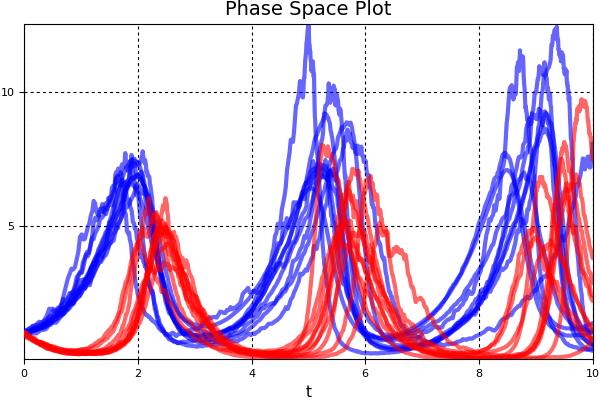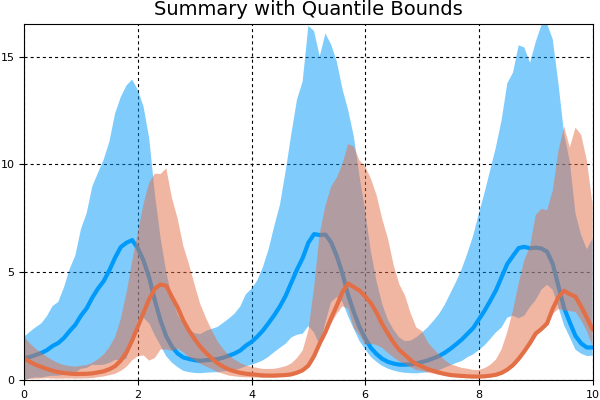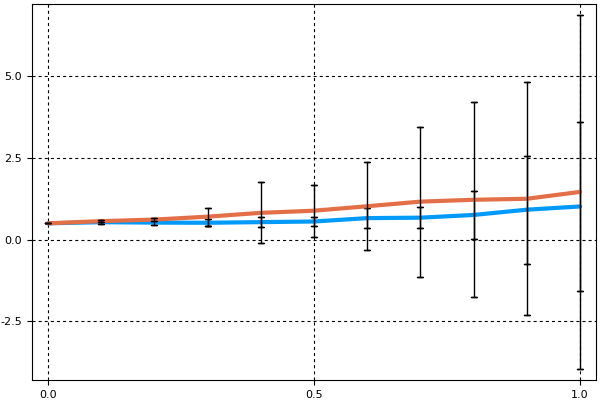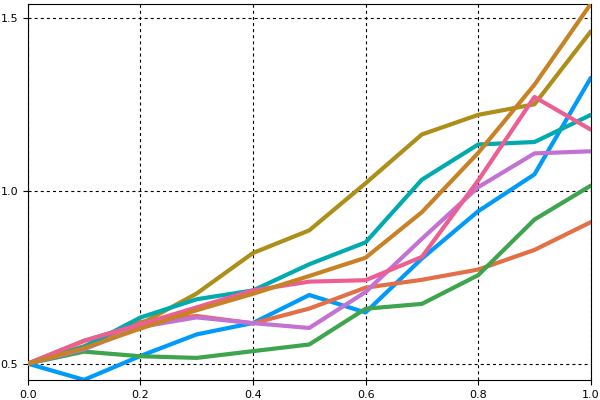Parallel Monte Carlo Simulations
Performing a Monte Carlo Simulation
Building a Problem
To perform a Monte Carlo simulation, define a MonteCarloProblem. The constructor is:
MonteCarloProblem(prob::DEProblem;
output_func = (sol,i) -> (sol,false),
prob_func= (prob,i,repeat)->prob),
reduction = (u,data,I)->(append!(u,data),false),
u_init = [])prob_func: The function by which the problem is to be modified.probis the problem,iis the unique id1:num_montefor the problem, andrepeatis for if the iteration of the repeat. At first it's0, but ifrerunwas true this will be1,2, etc. counting the number of times problemihas been repeated.output_func: The function determines what is saved from the solution to the output array. Defaults to saving the solution itself. The output is(out,rerun)whereoutis the output andrerunis a boolean which designates whether to rerunreduction: This function determines how to reduce the data in each batch. Defaults to appending the data from the batches. The second part of the output determines whether the simulation has converged. Iftrue, the simulation will exit early. By default, this is alwaysfalse.
One can specify a function prob_func which changes the problem. For example:
function prob_func(prob,i,repeat)
@. prob.u0 = randn()*prob.u0
prob
endmodifies the initial condition for all of the problems by a standard normal random number (a different random number per simulation). Notice that since problem types are immutable, it uses .=. Otherwise, one can just create a new problem type:
function prob_func(prob,i,repeat)
@. prob.u0 = u0_arr[i]
prob
endIf your function is a ParameterizedFunction, you can do similar modifications to prob.f to perform a parameter search. The output_func is a reduction function. It's arguments are the generated solution and the unique index for the run. For example, if we wish to only save the 2nd coordinate at the end of each solution, we can do:
output_func(sol,i) = (sol[end,2],false)Thus the Monte Carlo Simulation would return as its data an array which is the end value of the 2nd dependent variable for each of the runs.
Parameterizing the Monte Carlo Components
The Monte Carlo components can be parameterized by using the ConcreteParameterizedFunction constructors.
ProbParameterizedFunction(prob_func,params)
OutputParameterizedFunction(output_func,params)Here, the signatures are prob_func(prob,i,params) and output_func(sol,params). These parameters are added to the parameter list for use in the parameter estimation schemes.
Solving the Problem
sim = solve(prob,alg,collect_result = Val{true},kwargs...)This solve command has an extra keyword argument collect_result for whether to collect the result to a local array. If Val{true}, it will return a Vector of the results of output_func. If Val{false}, it will run each batch independently to form a DArray. Notice that parallel_type would be a layer of parallelism below this.
The keyword arguments take in the arguments for the common solver interface and will pass them to the differential equation solver. The special keyword arguments to note are:
num_monte: The number of simulations to run. Default is 10,000.parallel_type: The type of parallelism to employ. Default is:pmapifcollect_result, otherwise it'snone.batch_size: The size of the batches on which the reductions are applies. Defaults tonum_monte.pmap_batch_size: The size of thepmapbatches. Default isbatch_size÷100 > 0 ? batch_size÷100 : 1
The types of parallelism included are:
:none- No parallelism:threads- This uses multithreading. It's local (single computer, shared memory) parallelism only. Fastest when the trajectories are quick.:parfor- A multiprocessing parallelism. Slightly better thanpmapwhen the calculations are fast. Does not re-distribute work: each trajectory is assumed to take as long to calculate.:pmap- The default. Usespmapinternally. It will use as many processors as you have Julia processes. To add more processes, useaddprocs(n). See Julia's documentation for more details. Recommended for the case when each trajectory calculation isn't "too quick" (at least about a millisecond each?).:split_threads- This uses threading on each process, splitting the problem intonprocs()even parts. This is for solving many quick trajectories on a multi-node machine. It's recommended you have one process on each node.
Additionally, a MonteCarloEstimator can be supplied
sim = solve(prob,estimator,alg,kwargs...)These will be detailed when implemented.
Solution Type
The resulting type is a MonteCarloSimulation, which includes the array of solutions. If the problem was a TestProblem, summary statistics on the errors are returned as well.
Plot Recipe
There is a plot recipe for a AbstractMonteCarloSimulation which composes all of the plot recipes for the component solutions. The keyword arguments are passed along. A useful argument to use is linealpha which will change the transparency of the plots. An additional argument is idxs which allows you to choose which components of the solution to plot. For example, if the differential equation is a vector of 9 values, idxs=1:2:9 will plot only the Monte Carlo solutions of the odd components.
Analyzing a Monte Carlo Experiment
Analysis tools are included for generating summary statistics and summary plots for a MonteCarloSimulation.
Time steps vs time points
For the summary statistics, there are two types. You can either summarize by time steps or by time points. Summarizing by time steps assumes that the time steps are all the same time point, i.e. the integrator used a fixed dt or the values were saved using saveat. Summarizing by time points requires interpolating the solution.
Analysis at a time step or time point
get_timestep(sim,i) # Returns an iterator of each simulation at time step i
get_timepoint(sim,t) # Returns an iterator of each simulation at time point t
componentwise_vectors_timestep(sim,i) # Returns a vector of each simulation at time step i
componentwise_vectors_timepoint(sim,t) # Returns a vector of each simulation at time point tSummary Statistics
Single Time Statistics
The available functions for time steps are:
timestep_mean(sim,i) # Computes the mean of each component at time step i
timestep_median(sim,i) # Computes the median of each component at time step i
timestep_quantile(sim,q,i) # Computes the quantile q of each component at time step i
timestep_meanvar(sim,i) # Computes the mean and variance of each component at time step i
timestep_meancov(sim,i,j) # Computes the mean at i and j, and the covariance, for each component
timestep_meancor(sim,i,j) # Computes the mean at i and j, and the correlation, for each component
timestep_weighted_meancov(sim,W,i,j) # Computes the mean at i and j, and the weighted covariance W, for each componentThe available functions for time points are:
timepoint_mean(sim,t) # Computes the mean of each component at time t
timepoint_median(sim,t) # Computes the median of each component at time t
timepoint_quantile(sim,q,t) # Computes the quantile q of each component at time t
timepoint_meanvar(sim,t) # Computes the mean and variance of each component at time t
timepoint_meancov(sim,t1,t2) # Computes the mean at t1 and t2, the covariance, for each component
timepoint_meancor(sim,t1,t2) # Computes the mean at t1 and t2, the correlation, for each component
timepoint_weighted_meancov(sim,W,t1,t2) # Computes the mean at t1 and t2, the weighted covariance W, for each componentFull Timeseries Statistics
Additionally, the following functions are provided for analyzing the full timeseries. The mean and meanvar versions return a DiffEqArray which can be directly plotted. The meancov and meancor return a matrix of tuples, where the tuples are the (mean_t1,mean_t2,cov or cor).
The available functions for the time steps are:
timeseries_steps_mean(sim) # Computes the mean at each time step
timeseries_steps_median(sim) # Computes the median at each time step
timeseries_steps_quantile(sim,q) # Computes the quantile q at each time step
timeseries_steps_meanvar(sim) # Computes the mean and variance at each time step
timeseries_steps_meancov(sim) # Computes the covariance matrix and means at each time step
timeseries_steps_meancor(sim) # Computes the correlation matrix and means at each time step
timeseries_steps_weighted_meancov(sim) # Computes the weighted covariance matrix and means at each time stepThe available functions for the time points are:
timeseries_point_mean(sim,ts) # Computes the mean at each time point in ts
timeseries_point_median(sim,ts) # Computes the median at each time point in ts
timeseries_point_quantile(sim,q,ts) # Computes the quantile q at each time point in ts
timeseries_point_meanvar(sim,ts) # Computes the mean and variance at each time point in ts
timeseries_point_meancov(sim,ts) # Computes the covariance matrix and means at each time point in ts
timeseries_point_meancor(sim,ts) # Computes the correlation matrix and means at each time point in ts
timeseries_point_weighted_meancov(sim,ts) # Computes the weighted covariance matrix and means at each time point in tsMonteCarloSummary
The MonteCarloSummary type is included to help with analyzing the general summary statistics. Two constructors are provided:
MonteCarloSummary(sim;quantile=[0.05,0.95])
MonteCarloSummary(sim,ts;quantile=[0.05,0.95])The first produces a (mean,var) summary at each time step. As with the summary statistics, this assumes that the time steps are all the same. The second produces a (mean,var) summary at each time point t in ts. This requires the ability to interpolate the solution. Quantile is used to determine the qlow and qhigh quantiles at each timepoint. It defaults to the 5% and 95% quantiles.
Plot Recipe
The MonteCarloSummary comes with a plot recipe for visualizing the summary statistics. The extra keyword arguments are:
idxs: the solution components to plot. Defaults to plotting all components.error_style: The style for plotting the error. Defaults toribbon. Other choices are:barsfor error bars and:nonefor no error bars.ci_type: Defaults to:quantilewhich has(qlow,qhigh)quantiles whose limits were determined when constructing theMonteCarloSummary. Gaussian CI1.96*(standard error of the mean)can be set usingci_type=:SEM.
One useful argument is fillalpha which controls the transparency of the ribbon around the mean.
Example 1: Solving an ODE With Different Initial Conditions
Random Initial Conditions
Let's test the sensitivity of the linear ODE to its initial condition. To do this, we would like to solve the linear ODE 100 times and plot what the trajectories look like. Let's start by opening up some extra processes so that way the computation will be parallelized:
addprocs()
using DifferentialEquationsNow let's define the linear ODE which is our base problem:
# Linear ODE which starts at 0.5 and solves from t=0.0 to t=1.0
prob = ODEProblem((t,u)->1.01u,0.5,(0.0,1.0))For our Monte Carlo simulation, we would like to change the initial condition around. This is done through the prob_func. This function takes in the base problem and modifies it to create the new problem that the trajectory actually solves. Here we will take the base problem, multiply the initial condition by a rand(), and use that for calculating the trajectory:
function prob_func(prob,i,repeat)
ODEProblem(prob.f,rand()*prob.u0,prob.tspan)
endNow we build and solve the MonteCarloProblem with this base problem and prob_func:
monte_prob = MonteCarloProblem(prob,prob_func=prob_func)
sim = solve(monte_prob,Tsit5(),num_monte=100)We can use the plot recipe to plot what the 100 ODEs look like:
using Plots
plotly()
plot(sim,linealpha=0.4)
We note that if we wanted to find out what the initial condition was for a given trajectory, we can retrieve it from the solution. sim[i] returns the ith solution object. sim[i].prob is the problem that specific trajectory solved, and sim[i].prob.u0 would then be the initial condition used in the ith trajectory.
Pre-Determined Initial Conditions
In many cases, you may already know what initial conditions you want to use. This can be specified by the i argument of the prob_func. This i is the unique index of each trajectory. So, if we have num_monte=100, then we have i as some index in 1:100, and it's different for each trajectory.
So, if we wanted to use a grid of evenly spaced initial conditions from 0 to 1, we could simply index the linspace type:
initial_conditions = linspace(0,1,100)
function prob_func(prob,i,repeat)
prob.u0 = initial_conditions[i]
prob
endExample 2: Solving an SDE with Different Parameters
Using the Parameterized Function Wrappers
Let's solve the same SDE but with varying parameters. Instead of using the macro, we will use the parameterized function wrappers (though either can be used). Let's create a Lotka-Volterra system with multiplicative noise. Our Lotka-Volterra system will have as its drift component:
function pf_func(t,u,p,du)
du[1] = p[1] * u[1] - p[2] * u[1]*u[2]
du[2] = -3 * u[2] + u[1]*u[2]
end
pf = ParameterizedFunction(pf_func,[1.5,1.0])where pf is the function with the parameters 1.5 and 1.0 associated with it. For our noise function we will use multiplicative noise:
function pg_func(t,u,p,du)
du[1] = p[1]*u[1]
du[2] = p[2]*u[2]
end
pg = ParameterizedFunction(pg_func,[0.1,0.1])Now we build the SDE with these functions:
prob = SDEProblem(pf,pg,[1.0,1.0],(0.0,10.0))This is the base problem for our study. What would like to do with this experiment is keep the same parameters in the deterministic component each time, but very the parameters for the amount of noise using 0.3rand(2) as our parameters. Once again, we do this with a prob_func. In a ParameterizedFunctionf, the parameters are accessed at f.params. Thus we will modify those values in the prob_func. Note that in the SDEProblem, the noise function is referred to as g:
function prob_func(prob,i,repeat)
set_param_values!(prob.g,0.3rand(2))
prob
endNow we solve the problem 10 times and plot all of the trajectories in phase space:
monte_prob = MonteCarloProblem(prob,prob_func=prob_func)
sim = solve(monte_prob,SRIW1(),num_monte=10)
using Plots; plotly()
using Plots; plot(sim,linealpha=0.6,color=:blue,vars=(0,1),title="Phase Space Plot")
plot!(sim,linealpha=0.6,color=:red,vars=(0,2),title="Phase Space Plot")
We can then summarize this information with the mean/variance bounds using a MonteCarloSummary plot. We will take the mean/quantile at every 0.1 time units and directly plot the summary:
summ = MonteCarloSummary(sim,0:0.1:10)
pyplot() # Note that plotly does not support ribbon plots
plot(summ,fillalpha=0.5)
Note that here we used the quantile bounds, which default to [0.05,0.95] in the MonteCarloSummary constructor. We can change to standard error of the mean bounds using ci_type=:SEM in the plot recipe.
Example 3: Using the Reduction to Halt When Estimator is Within Tolerance
In this problem we will solve the equation just as many times as needed to get the standard error of the mean for the final time point below our tolerance 0.5. Since we only care about the endpoint, we can tell the output_func to discard the rest of the data.
function output_func(sol,i)
last(sol)
endOur prob_func will simply randomize the initial condition:
# Linear ODE which starts at 0.5 and solves from t=0.0 to t=1.0
prob = ODEProblem((t,u)->1.01u,0.5,(0.0,1.0))
function prob_func(prob,i,repeat)
ODEProblem(prob.f,rand()*prob.u0,prob.tspan)
endOur reduction function will append the data from the current batch to the previous batch, and declare convergence if the standard error of the mean is calculated as sufficiently small:
function reduction(u,batch,I)
u = append!(u,batch)
u,((var(u)/sqrt(last(I)))/mean(u)<0.5)?true:false
endThen we can define and solve the problem:
prob2 = MonteCarloProblem(prob,prob_func=prob_func,output_func=output_func,reduction=reduction,u_init=Vector{Float64}())
sim = solve(prob2,Tsit5(),num_monte=10000,batch_size=20)Since batch_size=20, this means that every 20 simulations, it will take this batch, append the results to the previous batch, calculate (var(u)/sqrt(last(I)))/mean(u), and if that's small enough, exit the simulation. In this case, the simulation exits only after 20 simulations (i.e. after calculating the first batch). This can save a lot of time!
In addition to saving time by checking convergence, we can save memory by reducing between batches. For example, say we only care about the mean at the end once again. Instead of saving the solution at the end for each trajectory, we can instead save the running summation of the endpoints:
function reduction(u,batch,I)
u+sum(batch),false
end
prob2 = MonteCarloProblem(prob,prob_func=prob_func,output_func=output_func,reduction=reduction,u_init=0.0)
sim2 = solve(prob2,Tsit5(),num_monte=100,batch_size=20)this will sum up the endpoints after every 20 solutions, and save the running sum. The final result will have sim2.u as simply a number, and thus sim2.u/100 would be the mean.
Example 4: Using the Analysis Tools
In this example we will show how to analyze a MonteCarloSolution. First, let's generate a 10 solution Monte Carlo experiment. For our problem we will use a 4x2 system of linear stochastic differential equations:
function f(t,u,du)
for i = 1:length(u)
du[i] = 1.01*u[i]
end
end
function σ(t,u,du)
for i in 1:length(u)
du[i] = .87*u[i]
end
end
prob = SDEProblem(f,σ,ones(4,2)/2,(0.0,1.0)) #prob_sde_2DlinearTo solve this 10 times, we use the MonteCarloProblem constructor and solve with num_monte=10. Since we wish to compare values at the timesteps, we need to make sure the steps all hit the same times. Thus we set adaptive=false and explicitly give a dt.
prob2 = MonteCarloProblem(prob)
sim = solve(prob2,SRIW1(),dt=1//2^(3),num_monte=10,adaptive=false)Note that if you don't do the timeseries_steps calculations, this code is compatible with adaptive timestepping. Using adaptivity is usually more efficient!
We can compute the mean and the variance at the 3rd timestep using:
m,v = timestep_meanvar(sim,3)or we can compute the mean and the variance at the t=0.5 using:
m,v = timepoint_meanvar(sim,0.5)We can get a series for the mean and the variance at each time step using:
m_series,v_series = timeseries_steps_meanvar(sim)or at chosen values of t:
ts = 0:0.1:1
m_series = timeseries_point_mean(sim,ts)Note that these mean and variance series can be directly plotted. We can compute covariance matrices similarly:
timeseries_steps_meancov(sim) # Use the time steps, assume fixed dt
timeseries_point_meancov(sim,0:1//2^(3):1,0:1//2^(3):1) # Use time points, interpolateFor general analysis, we can build a MonteCarloSummary type.
summ = MonteCarloSummary(sim)will summarize at each time step, while
summ = MonteCarloSummary(sim,0.0:0.1:1.0)will summarize at the 0.1 time points using the interpolations. To visualize the results we can plot it. Since there are 8 components to the differential equation, this can get messy, so let's only plot the 3rd component:
plot(summ;idxs=3)
We can change to errorbars instead of ribbons and plot two different indices:
plot(summ;idxs=(3,5),error_style=:bars)
Or we can simply plot the mean of every component over time:
plot(summ;error_style=:none)